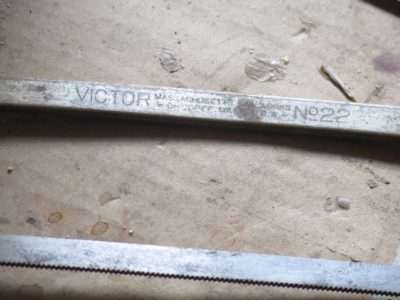Not Just For Cleaning Bathroom Fixtures Any More

Somewhere along the line I obtained a peculiar “hacksaw,” a Victor No.22 with a 1/8″ thick blade (IIRC Victor made tools for the machinist/metal-working trade).
I have no real idea about its true use, it seems to be more of a slot-cutting tool than a cut-off saw as are virtually all hacksaws I have ever encountered. Actually the closest tool I have to it is an edge float so perhaps that is its true purpose. Whatever its intended application I kept it hanging on a nail over my workbench and used it once or twice for reasons I cannot recall. But recently I found it to be a perfect tool for a particular task in a project I will describe in upcoming posts.

In order to use it for this purpose I needed to clean it up quite a bit to make sure the blades sides were nice and slick. Everything about it was dirty or rusty or both, the blade sides were downright crusty. In the past I would attack such surfaces with chemicals or sandpaper or abrasive pads, arrows that are still in the quiver. (For a remarkable website based in-part on tool restoration tutorials I comment highly one of my everyday reads, The Accidental Woodworker. Ralph is a blogging machine and humbles me for my lack of output.) I tried something different here.
In great part due to my work in historic finishing I have been gravitating towards pumice as a “go to” abrasive, and recognize its importance to the ancients for use in powdered and block form. Most woodworkers are well familiar with loose pumice, practically all of us have a container of FFFF pumice somewhere in the shop, but any familiarity we have with block pumice probably comes from a completely different context — removing rust stains from the toilet or sink. For just $2 or $3 they can be had at any hardware store or home center, packaged as “scouring sticks” or “porcelain cleaner blocks” or something similar. I keep several on hand so that they can be used for dedicated purposes.
Including removing rust and grime. They do get consumed fairly quickly in this process.


I dry-scrubbed the blade of this Victor “hacksaw” with the pumice block for two minutes, tops, and it was ready to go with a brilliant sheen polished into it. At some point in the very near future I will touch up the teeth with a file but for now it works just fine for what I need.



Join the Conversation!